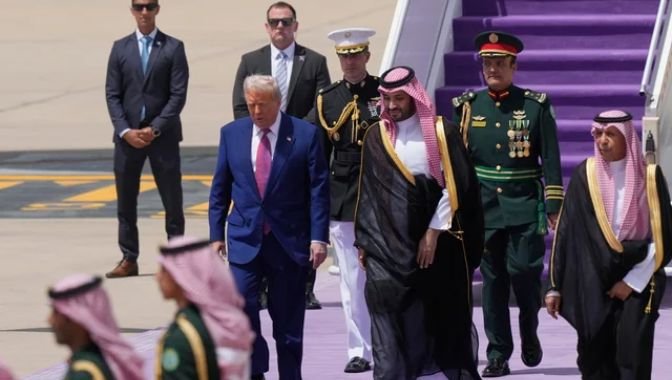In a highly anticipated state visit, Donald Trump, the 45th President of the United States, was welcomed with extravagant gestures by Saudi Arabia on the first day of his second-term foreign tour. The visit, which included a $600 billion deal, signals a new phase in U.S.-Saudi relations and a shifting dynamic in the Middle East. The deal covers a broad range of sectors, including defense, artificial intelligence, and technology, marking a massive step forward in the U.S. and Saudi Arabia’s strategic partnership.
The Lavish Welcome and $600 Billion Deal
As Trump’s Air Force One touched down in Saudi Arabia, the U.S. leader was greeted by fighter jets and a long-stretching guard of honor. This dramatic welcome set the tone for a visit that would yield major agreements between the two nations. Trump and Saudi Arabia’s Crown Prince Mohammed bin Salman discussed a wide-ranging deal worth $600 billion, which includes significant investments in defense systems, energy infrastructure, and artificial intelligence.
One of the largest components of this agreement is a $110 billion defense deal, the largest defense deal in U.S. history, which provides Saudi Arabia with advanced military equipment, strengthening the strategic alliance between the two nations. This deal not only deepens military ties but also opens doors for economic collaboration in technology, particularly in semiconductors, satellite communications, and AI — areas where companies like Nvidia, AMD, and Elon Musk’s Starlink are playing pivotal roles.
Lifting Sanctions on Syria
While the $600 billion deal with Saudi Arabia has captured significant attention, one of the most controversial aspects of Trump’s visit was his announcement regarding Syria. In a major shift in U.S. foreign policy, Trump declared plans to lift the U.S. sanctions imposed on Syria. This decision follows the rise of Ahmed al-Sharaa as Syria’s new leader in 2024, following the fall of Bashar al-Assad’s regime.
Trump is lifting sanctions as part of a broader strategy to open up investment opportunities in Syria, particularly in the oil and reconstruction sectors. The U.S. government has been looking at potential investment ventures in Syria, with real estate and infrastructure projects already being discussed, including a Trump Tower in Damascus. This move signals a new approach to diplomacy in the region, emphasizing economic engagement over the political disputes of the past.
Rebalancing Power in the Middle East
Trump’s visit to Saudi Arabia and the subsequent lifting of sanctions on Syria represent a recalibration of U.S. relations in the region. Unlike previous U.S. administrations, which focused on Israel as a primary ally, Trump has made it clear that Saudi Arabia and other Gulf nations are key partners in U.S. foreign policy moving forward. This shift is evident in the exclusion of Israel from Trump’s itinerary, signaling a focus on deepening ties with Saudi Arabia and its Gulf neighbors, including Qatar and the United Arab Emirates (UAE).
At the same time, lifting sanctions on Syria could change the geopolitical balance of power in the region. Critics of the decision warn that this could embolden authoritarian regimes in the Middle East, but others argue that it could provide much-needed stability to a region long embroiled in conflict.
Trump’s $600 billion deal with Saudi Arabia and the lifting of sanctions on Syria mark a bold shift in U.S. foreign policy, signaling a new era of economic diplomacy in the Middle East. By focusing on business and investment, Trump is reshaping the U.S.’s diplomatic approach and working to solidify ties with the Gulf states. The full impact of these decisions will unfold over the coming years, but it is clear that the U.S.-Saudi relationship has entered a new phase with significant global implications.
Also Read Karachi Water Shortage Continues Despite Pipeline Repairs











